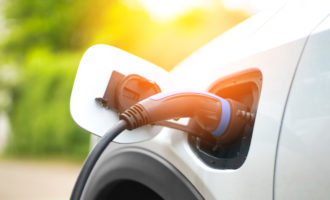The UK is now a net importer of goods and the port of Felixstowe is one of the main routes to bring these goods into the country. It is therefore no surprise that the economy in the east of England is heavily dominated by the transport and logistics sector, says Ben Cussons, Associate Partner.
The most recent figures published to the end of May 2023 by the government*, show that goods imported in the twelve-month period had a value of £901 billion compared to £842.7 billion exported. That is a lot of ‘things’ that needed to be moved. The hauliers responsible for moving these goods around the country are operating in a very capital-intensive industry, with a significant investment and/or commitment to a fleet of vehicles required to keep the economy going. These vehicles hold a significant balance sheet presence in these companies accounts and an important decision for hauliers and transport businesses is whether to lease or hire purchase (HP) their vehicles.
There’s no obvious answer to this question, and there are pros and cons for each route.
Purchase – either outright or on finance
Pros:
- Immediate Corporation Tax saving in the year of purchase based on 25% of the total costs of the asset, irrespective of whether bought outright or on finance
- 100% of the VAT can be reclaimed on the cost of the asset
- Shown as an asset of the company and strengthens the balance sheet • Once paid for the asset is yours and there is no immediate commitment to replace the asset, any future earnings out of the vehicle are yours
Cons:
- Requires initial outlay of cash in way of the deposit and funding of the VAT upfront • Significant liabilities used to borrow the money to finance the purchase of the asset may compromise raising additional finance
- You are responsible for the ongoing maintenance costs and as the asset’s future life shortens then these are likely to increase
Buying a truck on finance means you spread the cost over a period of time and the truck will belong to you at the end of the repayment period. Added to this, you can claim VAT back up front plus up to 25% in Corporation Tax reduction from day one, depending on your tax rates and where tax profits fall within the financial year. The truck will appear on your balance sheet as an asset (together with any associated acquisition costs), and because the HP finance is linked to the asset, it may be easier to source funding. At the end of the payment plan you will own the truck, to either keep using or sell on second hand.
However … you should bear in mind there may be limits to what you can afford. In addition to putting a deposit down, which at the very minimum will be the entire VAT value of the acquisition, the cost of servicing the debt may be difficult to maintain when other costs and revenues in your business may be fluctuating. Repayments will be over a set period, potentially longer than on a lease, adding a lot more debt to your balance sheet. Remember that buying outright will mean the responsibility of maintaining and servicing the vehicle is down to you, and the risks of dealing with expensive repairs like new tyres will need to be factored in.
Furthermore, you need to consider the impact of your current ratio which will be worsened by the addition of debt (an element of which will be a current liability). This is important for those businesses with borrowings that have financial covenants attached. Buying second-hand If you’re thinking of buying second hand rather than new, remember to factor in the number of miles the vehicle will be making, how it will be used, the cost of repairs to an aging vehicle, versus how much life is left in the truck.
Operating Leases
Pros:
- There is a reduced initial outlay of cash
- Fixed monthly spend, often includes maintenance costs built in to the monthly amount for the period of the lease.
- Nearly always a brand new vehicle leased
- Currently doesn’t show as a liability on the company’s balance sheet
Cons:
- No use of the asset once lease term expired
- Need to enter into a new contract to replace the asset
- VAT is claimed monthly on the lease rentals. 50% cap for cars
- May incur additional charges if you exceed the agreed usage as set out in the initial contract
Leasing is a popular option as there is currently a surplus supply of vehicles after the peak of the pandemic, and the leasing process will provide some certainty over outgoings as the repayments are fixed over a finite period. However other costs have risen, and leasing companies will be passing those on their clients, so don’t expect any irresistible deals. Many lease contracts will have a maintenance plan as part of the contract and there is a tax relief element as VAT can be claimed back as payments are made.
On the other hand, the most obvious point is that the vehicle will not belong to you, and you do not have the option to sell it, as you might with a vehicle bought on HP, if your business needs change, or if you need to liquify your assets. Leased assets and their associated liabilities are not (currently) included on the company’s balance sheet; instead, you must disclose operating lease commitments in the notes to the accounts.
Accounting Treatment
Purchase – if on finance
If you have taken out debt to finance the purchase of the asset, you will have a large asset and liability on the balance sheet. A deposit is likely to be required initially and then the asset will be brought over a set period, which is likely to be longer than a lease period would be. This would add a lot more debt to your balance sheet over time and represents a bigger commitment than leasing.
A fixed asset needs to be recognised for the acquisition costs which will then be depreciated over a number of years, often over the term of the lease. A liability is also recognised for the obligation of the future instalments of the agreement. Consequently, buying makes the company appear more profitable but results in a weaker balance sheet.
Accounting for operating leases
Under current FRS102 rules a company doesn’t need to show leased vehicles as an asset in the accounts or recognise the liability for the future obligations. The rental payments are just expensed to the statement of profit and loss, but a disclosure also needs to be included for the remaining commitment of the lease. This can make you seem less profitable but with a stronger balance sheet from a finance point of view.
However, change is expected to the current rules on leasing from January 2025 which will see the need for an asset and liability to be recognised, regardless of whether the company leases or buys. This change would see assets under operating leases capitalised on your balance sheet (the ‘right-of-use’ asset) with a corresponding lease liability within creditors. The asset is then depreciated over the shorter of the useful life of the asset and the lease term. There will still be a need to differentiate between assets brought and assets leased though as the accounting treatment behind them will differ.
Careful advance planning should be made once guidance has been published as this could significantly change the balance sheet for lessees, including the current ratio which – as noted above – many lenders may have written into financial covenants.
There is no obvious conclusion about whether leasing or purchasing is better as both have pros and cons. The decision should be made on the merits to your company and any future plans you may have.
If you would like further advice on the best way to proceed for your company, please give a member of our Business Advisory team a call on 0330 058 6559 or email hello@scruttonbland.co.uk







